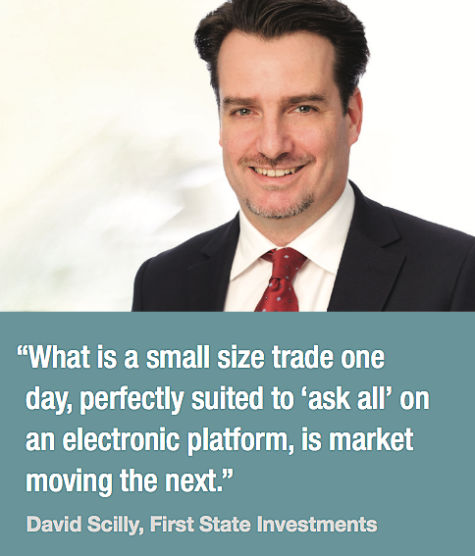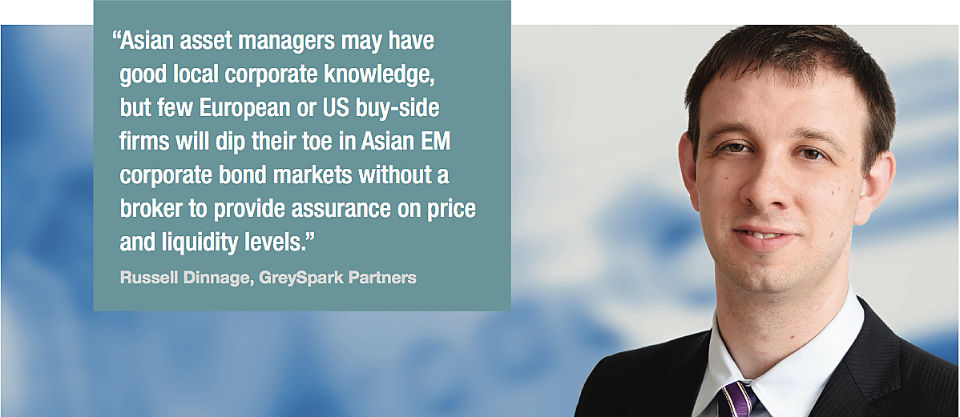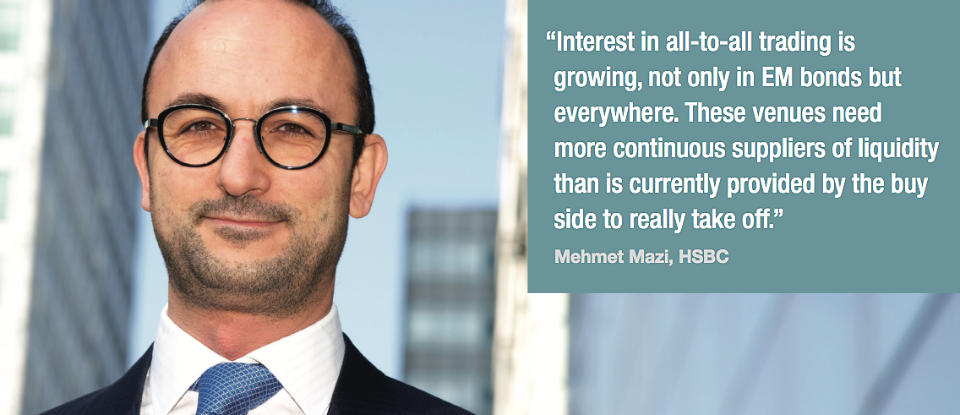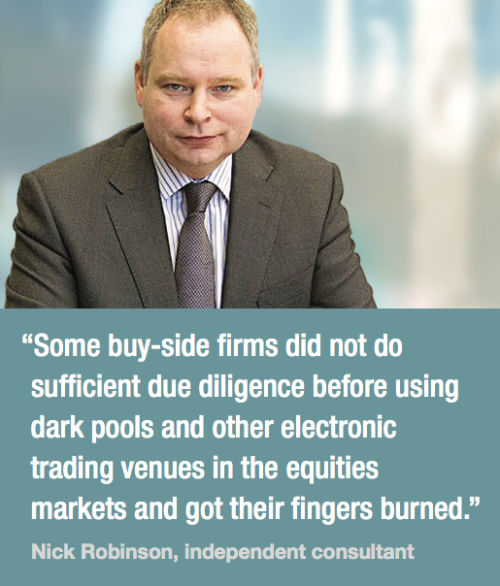Trading EM bonds electronically is showing growth, despite the challenges in matching. Chris Hall reports.
Emerging Market (EM) debt trading volumes recorded a 21% year-on-year rise in Q3 2016, at US$1.379 trillion, according to the Emerging Markets Traders Association (EMTA). With electronic trading commissions at five times those for equities, a big opportunity exists for venues that can wean asset managers off voice-broking.
Sourcing EM bonds has always been a headache for the buy side. Both demand and supply are highly unpredictable. An unexpected event can flood the market or dry it up overnight, even in very established issues, e.g. BRICS sovereign debt. Equally, a portfolio manager with a broad mandate could suddenly show an interest in a country, credit or instrument previously ignored. Even specialist EM managers struggle to keep open the channels required to source bond liquidity reliably across the world. Such niche firms have typically tried to feed a global network of local brokers, while generalists may rely on the reach of a global broker’s own sell-side relationships, supplemented by a handful of direct counterparties.
 This flexible approach extends to execution preferences, according to David Scilly, head of fixed income and currency dealing at First State Investments, which runs a dedicated EM team. “We utilise every resource available to us in the hunt for liquidity, treating each order differently depending on the instrument, size, direction and market conditions,” he says. “What is a small size trade one day, perfectly suited to ‘ask all’ on an electronic platform, is market moving the next day, and as such trading via voice is more appropriate.”
This flexible approach extends to execution preferences, according to David Scilly, head of fixed income and currency dealing at First State Investments, which runs a dedicated EM team. “We utilise every resource available to us in the hunt for liquidity, treating each order differently depending on the instrument, size, direction and market conditions,” he says. “What is a small size trade one day, perfectly suited to ‘ask all’ on an electronic platform, is market moving the next day, and as such trading via voice is more appropriate.”
The severity of the EM headache has intensified of late, primarily due to the higher balance sheet cost to banks of holding high-risk assets under Basel III, which has led some sell-side firms to limit their EM liquidity provision.
“Apart from a select few, banks are moving out of EM sectors in which they have lost money, concentrating their resources on areas where they are currently being successful. Many no longer feel the need to offer liquidity to their clients in all areas,” says Garry Stewart, deputy CEO, EMEA Broking, at interdealer broker (IDB) ICAP. “The top-tier banks are becoming more dominant as they are the only banks capable of quoting in bigger size and warehousing more risk.”
As incumbent banks and brokers slowly change their business models, new opportunities are being created for other service providers, including IDBs, regional banks, agency brokers, high-frequency traders and electronic trading platform operators. To succeed, their value propositions must accommodate EM’s inherent unpredictability.
Dealer-to-dealer (D2D) fixed income trading has been automated at a faster rate than the dealer-to-client (D2C) market, with buy-side firms slowest to adopt electronic trading in less-familiar markets, such as EM corporate credit.

“Asian asset managers may have good local corporate knowledge, but few European or US buy-side firms will dip their toe in Asian EM corporate bond markets without a broker to provide assurance on price and liquidity levels,” says Russell Dinnage, head of capital markets intelligence practice at GreySpark Partners.
While infrequent buy-side EM market participants and smaller trades from specialists might be executed electronically on request-for-stream (RFS) or request-for-quote (RFQ) venues, larger ticket deals from dedicated EM managers are still mainly voice-broked, according to Mehmet Mazi, global head of credit trading at HSBC.

“But interest in all-to-all trading is growing, not only in EM bonds but everywhere. These venues need more continuous suppliers of liquidity than is currently provided by the buy side to really take off,” he adds.
Nevertheless, some all-to-all electronic trading platforms – on which all market participants are able to make and take prices – are gaining momentum.
Changing pace
EM trading volume on MarketAxess reached US$63.27 billion in Q4 2016, a 59% increase on Q4 2015. A total of 14.5% of these trades were conducted via Open Trading, MarketAxess’s all-to-all service, a 7.7% annualised gain. Open Trading is currently only available for hard currency bonds, but MarketAxess expects to extend coverage to local currency bonds in H1 2017, dependent on establishing the necessary post-trade arrangements.

Sandy White, head of EM product management at MarketAxess, says a widening range of sell-side firms see electronic platforms as a cost-effective element of their fixed-income value proposition. “Increasingly, we’re seeing local banks with natural liquidity in their home country bonds servicing offshore clients via our platform that they would not otherwise be able to reach,” he notes.
But there are at least two barriers to the growth of all-to-all trading. The first is that buy-side firms need a change of mindset and an upgrade in pre-trade tools to trade confidently as price-makers, especially in periodically illiquid EM instruments; the second is that liquidity has dissipated across the multiple firms that have rushed into the vacuum created by Basel III-constrained banks.
The evolution of the matching services offered to its buy-side clients by Liquidity Finance is illustrative of challenges in aggregating EM bond liquidity. Having started with a voice-broked agency model, Liquidity Finance began exploring electronic models around five years ago, first providing HTML-based matching sessions, then instituting timed auctions to concentrate liquidity.
These proved popular in both D2C and D2D markets for many providers, but success has led to further fragmentation. Liquidity Finance also launched an all-to-all service but encountered difficulties as conflicts of interest arose between buy- and sell-side firms. It now offers three main options: request-for-quote (RFQ); timed auctions; and ‘black box’ portfolio matching.
“We’ve adopted a hybrid model across voice and electronic trading, because an electronic-only model is unsustainable over the volatility cycle,” says Faisal Mian, co-founder of Liquidity Finance. “We have to accept the complexity of EM bonds: different solutions will work for different clients at different points in time. Some buy-side firms are finding RFQ very useful at the moment, for example, because they’re not getting as much attention from their brokers and now need to widen the net.”
Alongside EM experts such as Liquidity Finance and global platform franchises such as MarketAxess, IDBs are also in a strong position to aggregate EM bond liquidity, as many existing clients rebalance from principal to agency-focused models.
But IDBs are still treading carefully in extending their value propositions to the buy side, despite their efforts to offer a wider range of trade support products and services. While some newer products are available to all market participants from launch, IDBs are wary of upsetting their traditional customer base where D2D models have been long established.
BrokerTec, a D2D electronic central limit order book for government bond and repo trading, allows some HFT participation alongside its core broker-dealer constituency, but offers no direct buy-side access, yet. Owner NEX (the recently separated and rebranded electronic trading unit of ICAP) is looking to innovate however, through the planned BrokerTec Direct, a separate venue in which liquidity providers will stream tailored prices directly to liquidity consumers in a disclosed environment, with the first customers being the corporates, asset managers and hedge funds that already trade FX on EBS Direct.
In the largely hybrid / voice broking businesses that ICAP sold to Tullet Prebon in Q4 2016 and now operating as a separate brand within the newly-formed TP ICAP Group, there is further buy-side-friendly innovation. Initially scheduled for launch in April 2016, I-SAM (ICAP Sponsored Access Matching) is intended to be a session-based matching platform for the credit markets, providing dealer-to-dealer liquidity for asset managers “while maintaining existing relationships and workflow”. Seth Johnson, now CEO of BrokerTec, confirmed in July 2016 that I-SAM would cover emerging market bonds, with an expansion to high-yield and investment grade credit shortly afterwards.
ICAP’s Stewart says the response to Basel-inspired sell-side retrenchment is well under way in the EM bonds space and beyond.
“We are seeing a bigger percentage of our trading activity occurring during matching sessions. With order book screen prices becoming both rarer and wider, the chance to trade at a mid-price has obvious economic advantages to many market participants, through matching sessions where all trades are transparent to all participants. Although we don’t currently offer all-to-all matching sessions some of our competitors do and seem to be gaining traction via this model,” he says.
 However, there is a risk in setting out your stall without having the right balance of supply and demand, not just to individual platform providers but to the take-up of electronic EM bond trading per se, due to the early-mover costs and risks to the buy side.
However, there is a risk in setting out your stall without having the right balance of supply and demand, not just to individual platform providers but to the take-up of electronic EM bond trading per se, due to the early-mover costs and risks to the buy side.
“Some buy-side firms did not do sufficient due diligence before using dark pools and other electronic trading venues in the equities markets and got their fingers burned,” observes Nick Robinson, formerly head of fixed-income trading at Schroders, now an independent consultant. “As such, they are being very cautious and deliberate in their selection process before connecting to fixed income platforms.”
©Markets Media Europe 2025












